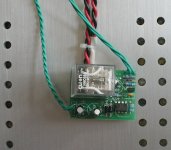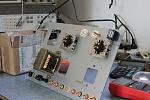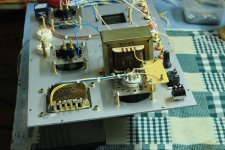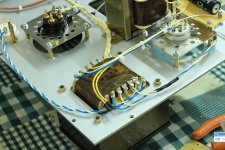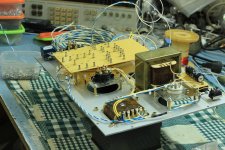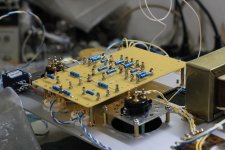Unlike the others, I disagree with the 25Hy value - it does not need to be this high. 10-15Hy is fine enough for single ended 2a3. There are other important factors to consider too.
For example I take the Tango XE-20s which is a very decent OPT but only has primary impedance of something like ~16 Henries on the 3.5k primary windings (into whatever correct load it is reflected into)
The -3dB low frequency cutoff point can be determined by the following formula:
f = Z/(2*Pi*L)
Z is the primary source impedance (reflected impedance in parallel with the source impedance presented by the tube's plate)
L is the primary inductance.
So lets take for example a 2a3 driving a Tango XE-20s on the 3.5K ohm taps. Lets run the 2a3 at 250V A-K biased at -45V on the grid giving an Rp of 800 ohm, just like in the RCA specs sheet.
Z= (3500 *800)/(3500+800) = 651 ohm
L= 16H
f= 651/(2*Pi*16) = ~6.5 Hz
I think you will agree that a 3db low frequency cut-off of around 10Hz or less is good enough.
So what else is important?
Voltage drop is a factor to look at, as well if there is any HF ringing and how well the transients are handled, so you need to consider DCR, leakage inductance and capacitance.
Very good OPT's will exhibit low DCR, low leakage inductance and low capacitance.
Then of course there is power handling and simple mechanical considerations (i.e. does it vibrate). Then you have to consider layout - how to best position it on your chassis. After all this then you have it really sorted.
Ian
sorry but very estimating calc, not giving the same results in praxis...
And lower inductance of Lp more shifting the phase, what is more important maybe against response...
But with higher inductance of primary rising number of turns, causing possible rise of capacitance. That could lead to loss in HF and also shift phase badly...
Yes, very good / excellent OT exhibit this values You said as low
BUT almost any OT with lower number of turns will exhibit the same?
So without Inductance of primary like basic figure, really does not telling us much...
My opinion is to target higher Lp inductance, BUT with low Capacitance, and Leakage inductance... 🙂
Last edited:
I don't see what the advantage of a tuneable choke would be? Except for the manufacturer? I've used these Triad chokes for years. They range from about $10 to $20.
Low Frequency (Inductor) Chokes On Triad Magnetics
Low Frequency (Inductor) Chokes On Triad Magnetics
Guitar amplifier designers may find that useful. Some may like to dial in the right amount of regulation and sag or lack there of in order to create compression. It's a very subjective thing with guitar amps and players like myself like some amount of squish.
Member
Joined 2009
Paid Member
I wouldn't advise copying a schematc. A two stage amp will be easy enough to design from scratch with the help from everyone on here. At the end of the day you will hold your head higher knowing you didn't just copy a schematic. Don't worry it will sound lovely.
So instead of taking a proven design, we're going to have folk here, who he doesn't know, never met, decide how he's going to design his 'once in a lifetime' project here on the internet, and the thread is already talking about guitars amp chokes.🙄
Member
Joined 2009
Paid Member
A member on this forum, Azazello (Nikola Nikolov), built a simple 2 stage amp that he was very pleased with, perhaps his input would be good if the plan is to have the forum 'team' design this amp 😀
I've taken the liberty of posting his design - a schematic from his blog. Note: "Now 33 kom is 15 kom and 12 kom is 3 kohm, +U is 316 v, not 270 v"
I've taken the liberty of posting his design - a schematic from his blog. Note: "Now 33 kom is 15 kom and 12 kom is 3 kohm, +U is 316 v, not 270 v"
Attachments
Last edited:
I remind the members that the OP has, among other things, a Hammond power trafo in hand and its rectifier winding is 300-0-300. IMO, what is needed is well proven, good performing, circuitry that fits stuff already on hand. Selecting suitable portions from existing designs meets the need and is unlikely to result in (horrors) failure.
Taken Back A Little
Hi,
Amongst the many good suggestions and points of advice in this thread from some good folks. I am unsettled by whatever one would call the recent tone. I thought asking for some advice and tossing around ideas was the point of places like this, "a forum". : a place or opportunity for discussing a subject- Merriam- Webster. I mean no harm, I have no experience with many of the topics discussed herein, and on the list of components I know I need to aquire is a choke. For me to float the inquiry of the Mercury device seems reasonable, given what I know. Tho the useage of such an item may very well be ludicrious in this application, I would have no way to know that-unless I ask. I've constructed a lot of resistance welders and a lot of special machinery, all of which were solid state, PLC and point to point wiring, (connected). The pace of the progression with my project and my understanding of the related topics may very well be frustrating to some. For those that this is the case, don't trouble yourself, I would suggest that your time would be better spent elsewhere. I am sitting here with a pack of poison being pumped into a port in my chest. I have enjoyed the distraction of applying my thoughts to something other than my current situation, believe me, this project has become a very welcome distraction, no violins - just where I am at. Before this thread is consumed by flames, I would like to express my sincere appreciation to Eli, Famousmockingbird, AJT, and the other positive contributors to my experience here, thank you VERY much -I have learned from you! I will build this thing, I will use the parts my kids and Santa got me for Christmas, and I will have a great time doing it. And it won't be a waste of time like this and what might be said of some of the recent posts here.
Thank you all very much for your help!
regards,
Ron
Hi,
Amongst the many good suggestions and points of advice in this thread from some good folks. I am unsettled by whatever one would call the recent tone. I thought asking for some advice and tossing around ideas was the point of places like this, "a forum". : a place or opportunity for discussing a subject- Merriam- Webster. I mean no harm, I have no experience with many of the topics discussed herein, and on the list of components I know I need to aquire is a choke. For me to float the inquiry of the Mercury device seems reasonable, given what I know. Tho the useage of such an item may very well be ludicrious in this application, I would have no way to know that-unless I ask. I've constructed a lot of resistance welders and a lot of special machinery, all of which were solid state, PLC and point to point wiring, (connected). The pace of the progression with my project and my understanding of the related topics may very well be frustrating to some. For those that this is the case, don't trouble yourself, I would suggest that your time would be better spent elsewhere. I am sitting here with a pack of poison being pumped into a port in my chest. I have enjoyed the distraction of applying my thoughts to something other than my current situation, believe me, this project has become a very welcome distraction, no violins - just where I am at. Before this thread is consumed by flames, I would like to express my sincere appreciation to Eli, Famousmockingbird, AJT, and the other positive contributors to my experience here, thank you VERY much -I have learned from you! I will build this thing, I will use the parts my kids and Santa got me for Christmas, and I will have a great time doing it. And it won't be a waste of time like this and what might be said of some of the recent posts here.
Thank you all very much for your help!
regards,
Ron
Member
Joined 2009
Paid Member
I am unsettled by whatever one would call the recent tone.
Sorry Ron, assuming you mean me, I'll bow out. I thought I had your interests at heart when I made my post but I misread your wishes. All the best with your build - and with the ups and downs that your treatment will bring (all too familiar in my family).
We aren't reinventing the wheel here. He has the output tubes and transformers along with a power transformer. The only thing really up in the air here that I can see is the driver stage. The OP along with several highly regarded members agree upon running those beautiful 2A3's AC coupled with an operating point suggested by tube manufacturer. In the end it's entirely up to the OP what he does but I like the idea of members suggesting different driver scenarios so he can research all of them and pick one that he likes.
And to Ron, you are very welcome. Keep on fighting what it is that's currently got you down. Before you know it you will be listening to a fabulous amp built with your own two hands. You will also meet great people on here with great advice. Without a question this sort of hobby will help keep the mind off other things. I spent most of my hospitalizations tormenting everyone here, it's a lot of fun!
Once you decide on a driver stage and the total current draw is realized the power supply values can be chosen.
Once you decide on a driver stage and the total current draw is realized the power supply values can be chosen.
Quick Peek
Hi,
"' tis a wealthy man who can afford to throw away a friend ", or something like that. No need for anyone to bow anywhere, I need all the help I can get!!!
The choke thing has already garnered good feedback. I know now not to bother with "them thar Mercury's" . I opened my 300b amplifier ASL1010, just to get a real good look at what I am biting off here (photo attached). I noticed some things, there are SS rectifiers for each of the tubes (??) They each come from an individual trim pot labeled "HUM" and go to each 300b. I am trying to get a schematic but it's probably doubtful. Just a curiosity for now. I never looked inside so I was surprised to see that a lot of the capacitors, resistors and such are just kind of "floating", soldered to solid wires here and there. More wire bundling than I thought I'd see, but a pretty neatly arranged job anyway. Each channel has 1-5AR4, 2-6NS7, 2-300b. And what really sticks out to me is that if twisting the filament wires really keeps the hum down. I now know why this amp hums. There is very little of that twisting in this construction. I was sure to discharge the caps through a resistor when I opened it. Rewiring the filaments will be for next winter I guess.
thanks!
Ron
Hi,
"' tis a wealthy man who can afford to throw away a friend ", or something like that. No need for anyone to bow anywhere, I need all the help I can get!!!
The choke thing has already garnered good feedback. I know now not to bother with "them thar Mercury's" . I opened my 300b amplifier ASL1010, just to get a real good look at what I am biting off here (photo attached). I noticed some things, there are SS rectifiers for each of the tubes (??) They each come from an individual trim pot labeled "HUM" and go to each 300b. I am trying to get a schematic but it's probably doubtful. Just a curiosity for now. I never looked inside so I was surprised to see that a lot of the capacitors, resistors and such are just kind of "floating", soldered to solid wires here and there. More wire bundling than I thought I'd see, but a pretty neatly arranged job anyway. Each channel has 1-5AR4, 2-6NS7, 2-300b. And what really sticks out to me is that if twisting the filament wires really keeps the hum down. I now know why this amp hums. There is very little of that twisting in this construction. I was sure to discharge the caps through a resistor when I opened it. Rewiring the filaments will be for next winter I guess.
thanks!
Ron
Attachments
Ron,
I'm sorry to hear about your medical issues. Hang tough. If friends are of any medicinal value, you have them at this cyberspace location.
Demon Hum has been mentioned. There are several techniques for putting that ugly bugger on the run.
Check out signal grounding schemes. Preventing ground loops is very important. A single point ground (SPG) is best. Real world methods approaching the ideal SPG are star and bus. Do not use the chassis to carry signal. Use the chassis for mechanical support and shielding.
Building a regulated 12 VDC heater supply is easy. Such a supply could be used with "12" V. heater versions of the small signal tubes that have already been mentioned. For instance, the cascaded 6SN7 circuitry I'm somewhat keen on could be executed with 12SN7s or the less costly Loctal 14N7s.
You have all sorts of options, in several areas. Get the ducks lined up and have at it.
I'm sorry to hear about your medical issues. Hang tough. If friends are of any medicinal value, you have them at this cyberspace location.
Demon Hum has been mentioned. There are several techniques for putting that ugly bugger on the run.
Check out signal grounding schemes. Preventing ground loops is very important. A single point ground (SPG) is best. Real world methods approaching the ideal SPG are star and bus. Do not use the chassis to carry signal. Use the chassis for mechanical support and shielding.
Building a regulated 12 VDC heater supply is easy. Such a supply could be used with "12" V. heater versions of the small signal tubes that have already been mentioned. For instance, the cascaded 6SN7 circuitry I'm somewhat keen on could be executed with 12SN7s or the less costly Loctal 14N7s.
You have all sorts of options, in several areas. Get the ducks lined up and have at it.
Member
Joined 2009
Paid Member
My 2A3 is still not built so the only real experience I have is from a 6C4C amp which is a tube that comes pretty close to being a 2A3. I heard it driven through a Hammond IT with both a trioded 6E5P and a 6C45P. They both sounded very good, the 6E5P a little more mellow, the 6C45P more dynamic. I could have lived happily with either of them.
(My own 2A3 amp will be a Dennis Fraker design, dc-coupled, driven by a 12AX7 - not suitable for this thread and not at all a choice many here would accept.)
My other SET amp uses 6SN7 to drive a low mu IDHT tube. There's not enough gain with a single stage 6SN7, which means cascading. I have no experience of 3 stage SETs, but I'd be scared off by the need to optimize that arrangement for the right sound.
(My own 2A3 amp will be a Dennis Fraker design, dc-coupled, driven by a 12AX7 - not suitable for this thread and not at all a choice many here would accept.)
My other SET amp uses 6SN7 to drive a low mu IDHT tube. There's not enough gain with a single stage 6SN7, which means cascading. I have no experience of 3 stage SETs, but I'd be scared off by the need to optimize that arrangement for the right sound.
Last edited:
My other SET amp uses 6SN7 to drive a low mu IDHT tube.
I was going to suggest his power transformer may be able to handle this arrangement, I was thinking of the 6EM7. I will have to look at the Hammond datasheet again. I tried this briefly driving a 6HJ5 triode strapped, my Hammond 272HX was too stressed with that arrangement. I was running 85mA with the 6HJ5's where as Ron will be running his 2A3's at 60mA, he might have enough HT current depending on power supply total C. It sounded good when I had it breadboarded😀 Power transformer was not so happy.
Again
Hi, I have been reading again, (bad). And I am considering the supposed impact of immediate b+ without the tubes heating up. The 3 approaches I have found and surely there are more are-
for the PS rectifier:
http://www.situbes.com/File_Downloads/SiTDR.pdf
or a circuit board (pic attached)
info for the circuit board:
This board would permit to warm up vacuum tube filament first, and then switch to high plate voltage in about 20 - 30 seconds later. To protect your expensive output vacuum tubes such as 300B/2A3/845, KT88/El34 ... to achieve longer lifespan, you need to get this delay action board (assembled, ready for use). Buy it today!
Price: $30 each + $5 shipping for the first board, $2 for each additional board
any thoughts?
Thanks for the regroup!!
Ron
Hi, I have been reading again, (bad). And I am considering the supposed impact of immediate b+ without the tubes heating up. The 3 approaches I have found and surely there are more are-
for the PS rectifier:
"A 5AR4 is recommended because of it’s slow warm up characteristics. This allows all of the amplifier tubes time to warm up before the plate voltage is applied"
a tube type relay to delay b+
http://www.situbes.com/File_Downloads/SiTDR.pdf
or a circuit board (pic attached)
info for the circuit board:
This board would permit to warm up vacuum tube filament first, and then switch to high plate voltage in about 20 - 30 seconds later. To protect your expensive output vacuum tubes such as 300B/2A3/845, KT88/El34 ... to achieve longer lifespan, you need to get this delay action board (assembled, ready for use). Buy it today!
Price: $30 each + $5 shipping for the first board, $2 for each additional board
any thoughts?
Thanks for the regroup!!
Ron
Attachments
Ron,
Cathode stripping is a problem at very high anode voltages, well above those employed with 2A3s. Being directly heated, 2A3s turn on very quickly. A 5AR4s slow startup time is more than adequate to protect your costly EML tubes. You could opt for instant on, SS rectified, "fixed bias" and electrostatically protect the 2A3s' filaments.
In short, there is nothing to obsess over. I'm keen on the cascaded, cap. coupled, 6SN7 small signal circuitry because it adheres to the KISS (keep it simple stupid) principle and is very well proven. Paraphrasing Einstein, simple, but not too simple, is good. I want you to succeed.
Cathode stripping is a problem at very high anode voltages, well above those employed with 2A3s. Being directly heated, 2A3s turn on very quickly. A 5AR4s slow startup time is more than adequate to protect your costly EML tubes. You could opt for instant on, SS rectified, "fixed bias" and electrostatically protect the 2A3s' filaments.
In short, there is nothing to obsess over. I'm keen on the cascaded, cap. coupled, 6SN7 small signal circuitry because it adheres to the KISS (keep it simple stupid) principle and is very well proven. Paraphrasing Einstein, simple, but not too simple, is good. I want you to succeed.
I always make sure the power supply capacitor voltage rating can handle peak voltage for worst case scenario like no tubes (load) in the amp while turned on. Other than that there is nothing to worry about.
Power
Hi, after yaking with a few people about the Hammond 302ax. I' wondering if I should save it for a later project and get something with some reserve should I decide to add the second 2a3 to the PSE design that I going to build?
If so then what, add another 302ax and rectifier tube( dual power supply). Or get a complete different transformer. (prefered). This route gives us the fun of shopping!
Any thoughts? Recommendations for a different unit?
Thanks,
Ron
(married 38 yrs today!)
Hi, after yaking with a few people about the Hammond 302ax. I' wondering if I should save it for a later project and get something with some reserve should I decide to add the second 2a3 to the PSE design that I going to build?
If so then what, add another 302ax and rectifier tube( dual power supply). Or get a complete different transformer. (prefered). This route gives us the fun of shopping!
Any thoughts? Recommendations for a different unit?
Thanks,
Ron
(married 38 yrs today!)
Impressed
Hi,
This looks good to me as something I want to try to have in this build.
Does using turret posts on a board cause any problems? Just seems like a more neat and organized way to do things as opposed to the snap of my 300b commercial amp.
thoughts?
thanks,
Ron
Hi,
This looks good to me as something I want to try to have in this build.
Does using turret posts on a board cause any problems? Just seems like a more neat and organized way to do things as opposed to the snap of my 300b commercial amp.
thoughts?
thanks,
Ron
Attachments
- Status
- Not open for further replies.
- Home
- Amplifiers
- Tubes / Valves
- 2A3 driver


